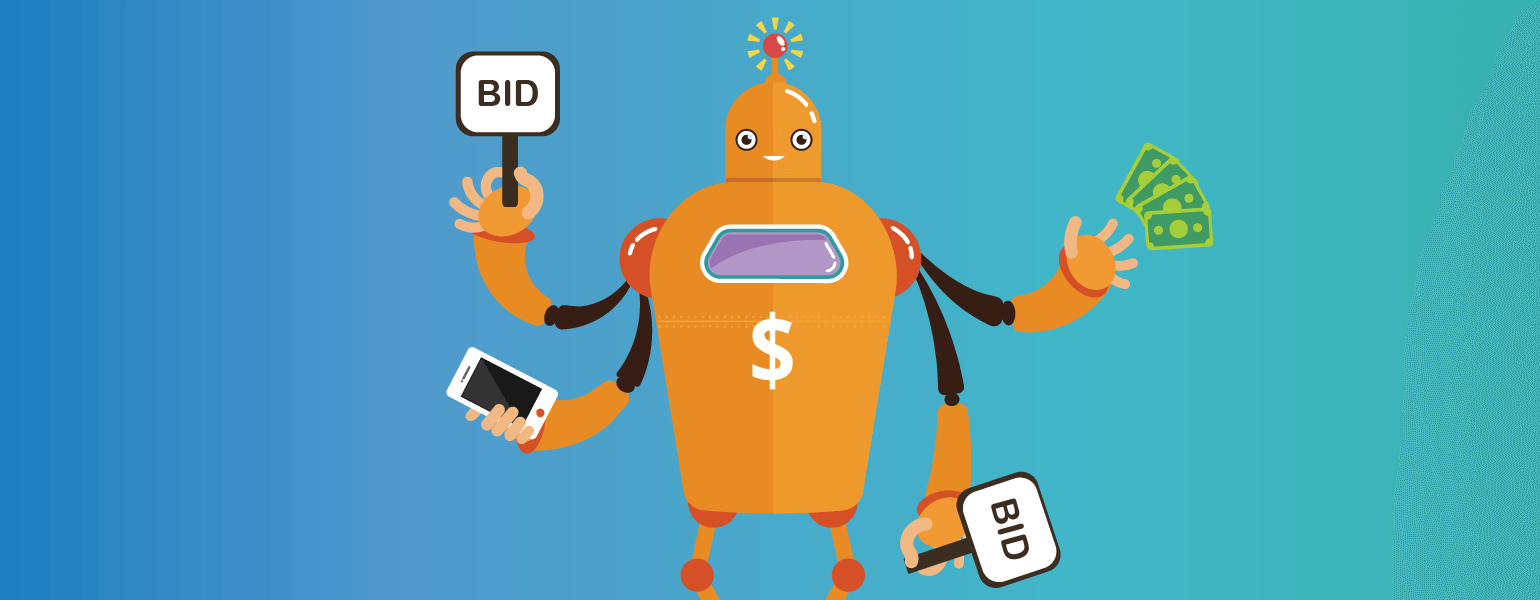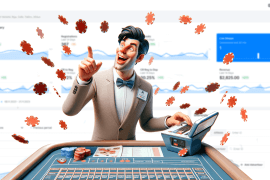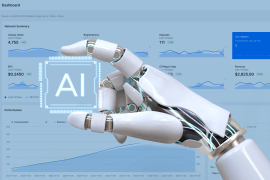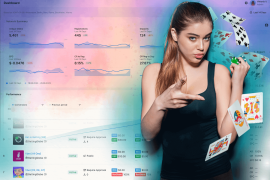The programmatic advertising system is the method of automating the purchasing and selling of advertising inventory in real-time by an automated bidding system. Programmatic advertising allows brands or companies to buy ad impressions on publisher websites or apps in less than a second, through an advanced ecosystem.
This blog post covers programmatic advertising basics, how it operates, the different kinds of programmatic media buying, programmatic ad channels, and its benefits.
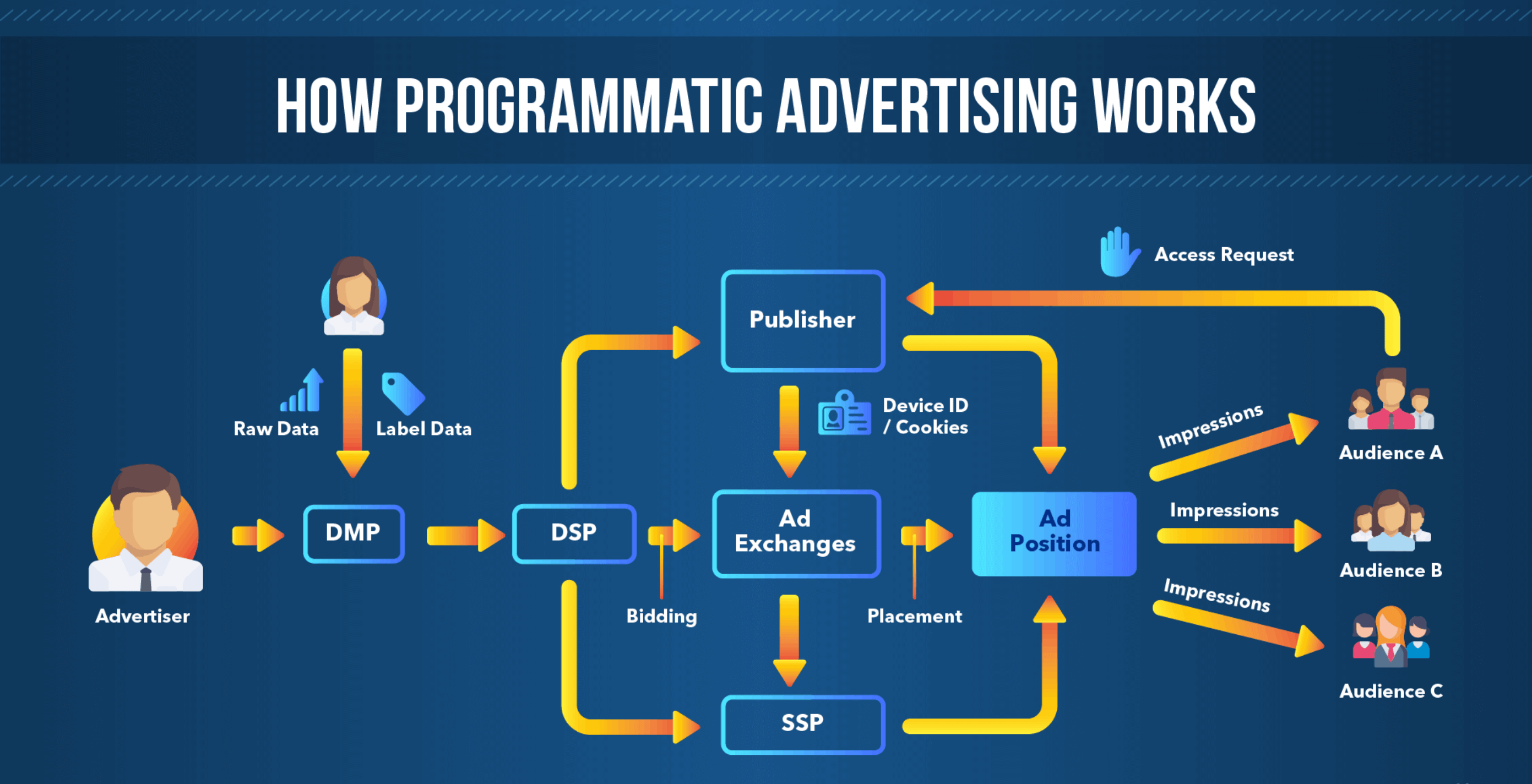
Efficiently capturing consumers’ in today’s digital ecosystem is not a simple job, which is why we’re going to discuss Programmatic Advertising in 2021.
There are billions of websites, apps, and digital assets viewed across various channels, all day long, every single day.
Using various platforms to advertise on separate channels and selecting the best spots to put your advertisements in the online world is an increasingly daunting chore.
Programmatic advertising solves this problem.
Programmatic advertising is an automatic process of buying and selling advertising online.
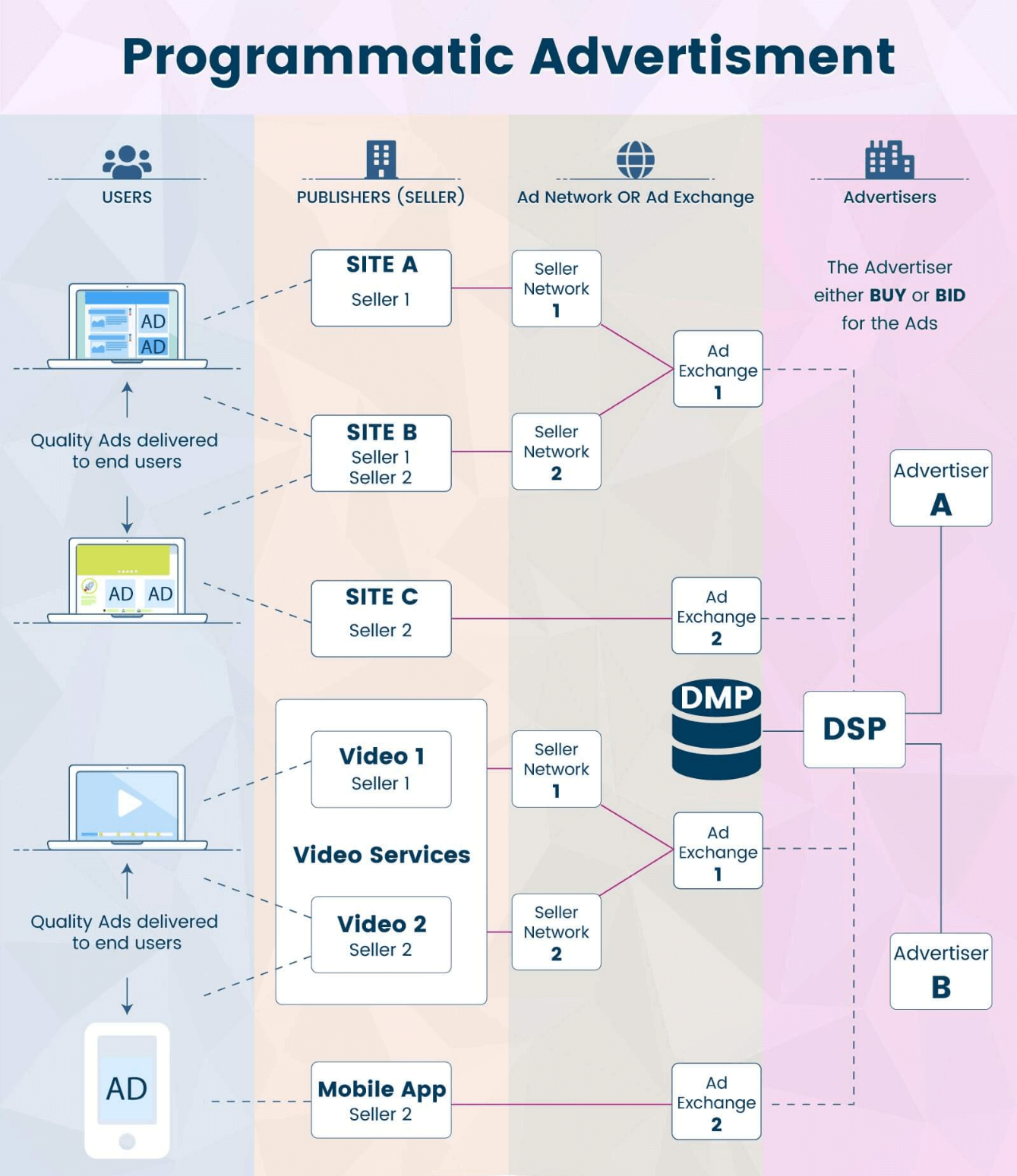
This automation process makes buying efficient and more useful, streamlining the practice and connecting your advertising endeavors in one technology platform.
Programmatic platforms have been developing and growing their database so that any format and or ad channel can be reached programmatically, including mobile, desktop, tablet, digital outdoor equipment, and connected TV.
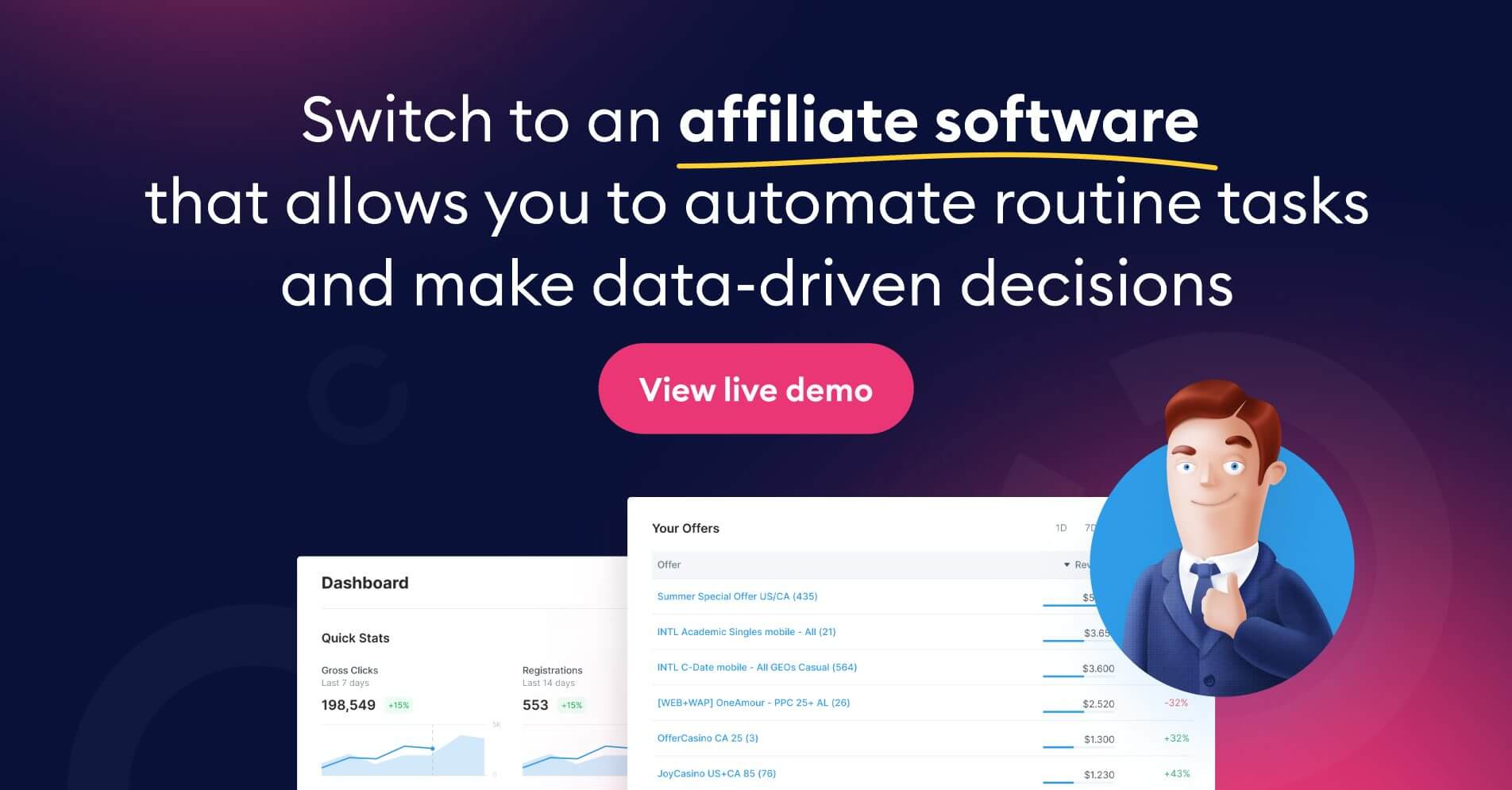
Targeting approaches are used for segmenting audiences using data such that marketers pay only for advertisements to the right people at the right time and rely less on the “spray and pray” approach of digital advertising. Computers and algorithms make the ad-purchase placement and optimization process more efficient, minimize worldly operation, and reduce time to market.
An example of how the IRL functions for programmatic advertising:
Advertiser Completely Tubular is seeking to market more surfboards.
It hires a programmatic advertising network that is capable of defining online users through such aspects as:
- Demographics (male/female/18-45),
- Geography (3 minutes from the beach)
- Interest (surfing, saltwater, California)
- Behavior (consume the material of surfing during their lunch break)
- Daytime (7-10 pm)
- Computer (smartphone)
The platform then uses real-time data to determine the best online audience(s) for the campaign and purchases digital ad inventory via an auction-based on everything available through different devices in locations that the audience cares about.
Advertisements are customized based on the particular preferences and actions of each user.
Intelligent relations are created, insights are produced, and output is optimized.
Programmatic advertising added US$25.48 billion to the digital advertising industry in 2016, up from US$17.5 billion in 2015, according to eMarketer. It is expected to hit US$45.72 billion by 2019, which means that the industry will have expanded more than two and a half times in just four years.
What’s the secret to the success of programmatic platforms?
At the heart of each programmatic advertisement, the platform is a patented machine-learning algorithm that analyzes campaign inputs and user activity to make real-time campaign optimizations, and consumers that are most likely to convert are detected and targeted. Different forms of data come into play to maximize the likelihood of success of a campaign.
So what are the benefits of Programmatic Ads?
There are many advantages to the use of a programmatic advertising platform for all your digital advertising activities. First and foremost, programmatic advertising lets buyers and sellers make data-driven decisions and eliminates the ad buying process’s guesswork.
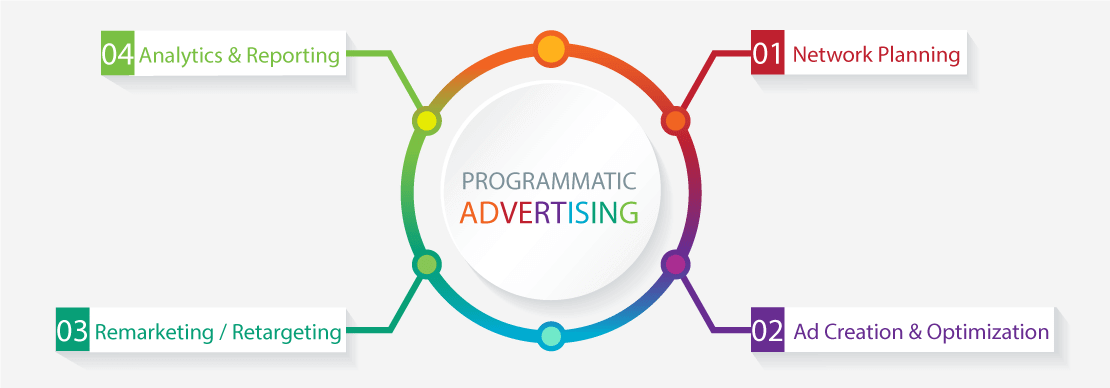
Here are some of the additional advantages of programmatic advertising:
Yeah, it’s nice for your budget. Programmatic technology generates productivity by using machine learning to maximize campaign performance, eliminating inefficient inventory.
Improved targeting. You’ll find it hard to find a technology platform that allows you to target across as many different strategies, across platforms, in real-time.
We also simplified campaign management. Consolidating campaigns in one framework across platforms and formats helps you to see progress in one place.
Simple access to ad inventory. Advertisers are able to access an optimal inventory across a number of exchanges at once and allow the AI algorithm to do the heavy lifting in bidding.
Is Programmatic Ads the Future of Publicity?
Programmatic advertisement allows advertisers to efficiently embed messages through the target platforms and maximize the Share of Attention(R), enter the most attractive audiences and demographics, and use data to recognize new opportunities.
Via automation and machine learning, programmatic, create an ecosystem that allows advertisers to reach their most meaningful audiences more effectively than ever before using digital media to achieve the best performance.
However, the future of ads is not a programmatic one. It’s here already. Suppose you are not already taking advantage of its ability in some capacity. In that scenario, you’re losing out on the opportunity to save money and have better results in your online advertisement campaigns.
What’s Programmatic Advertising? Definitions, Forms, Channel, and Advantages
Programmatic advertising uses a program to buy ad slots on publishers. Artificial Intelligence (AI) driven algorithms analyze users on the basis of their actions, demographic data, cookie data, and other parameters for deciding which ad should be displayed to each user.
Advertisers use the DSP to promote the ad-purchase process and the DMP to use third-party consumer data (brands can combine first-and third-party data with improving targeting capabilities). Publishers use the SSP to control their ad inventory. The final call is made by SSPs to determine which ads to serve, based on the bids.
Types of Programmatic ads media purchases
In comparison to the conventional media purchasing model, programmatic advertising cannot inherently include marketers and publishers collaborating on a one-on-one basis to serve advertisements. The distribution of the ad depends on the type of programmatic arrangement chosen.
Real-Time Offering (RTB)
Also known as open auction or open marketplace, this real-time bidding (RTB) system has become synonymous with programmatic media buying mostly because of its widespread use.
Ad slots are available to anyone in RTB and are sold through an open auction method of bidding. The highest bidder will get the spot. The entire process occurs in real-time, and advertisers can select ad slots as they are made available.
Since the highest bidder gets the RTB slot, they don’t have to pay their bid sum to get the slot. RTB follows the auction type known as the second-price auction. In second-price auctions, the top bidder will be paid just $0.01 more than the second-highest bidder for the slot. The second highest bidder is paid marginally more than the third-highest bidder, and so on.
While RTB is easy to set up and optimize, it lacks clarity from the advertiser’s point of view. Advertisers know the general segment of publishers, but they do not know the exact publisher websites on which their advertisements will appear.
Private Marketplace (PPM)
The private marketplace works in similar veins to RTB, except that it is open to marketers on an invitation-only basis. In private or closed auctions, publishers typically set aside a premium inventory reserved for select advertisers only. Many DSPs have their own PMPs that are only available to DSP users/customers.
Considering the advantages it provides to authors, blogs, and mass-produced magazines, PMPs are mainly used. In comparison to RTB, an advertiser using a PMP knows on the websites their advertisements are being served, enabling them to calculate the accuracy of the ROI of their ads.
Preferred Offer
In preferred offers, marketers will be able to select an ad inventory at a fixed price before it is made available on private markets, followed by an open auction.
Often known as spot sales, negotiations on preferred offers take a refined approach as all sides negotiate on pricing, targeting, etc., in advance.
The advertiser is given a snapshot of the publisher’s ad inventory and is not bound to make any purchases. Advertisers may use the DSP to consider their audience and to decide whether to buy the ad impression.
Guaranteed Programmatic Ads
Programmatic ads guaranteed, also known as programmatic direct or automatic guaranteed, follows a conventional media purchasing strategy. Here the advertiser and publisher are negotiating the terms on a one-on-one basis.
Unlike the other forms of media purchasing, we looked at the programmatic direct does not obey the bidding process. After the agreement, the inventory is sold directly to the advertiser. Programmatic guaranteed offers marketers the freedom to choose when it comes to ad inventories, costs, viewer targeting, and frequency limits.
Automated warranty is used by advertisers who know exactly where to put their ads and have high advertising budgets.
Top 6 Programmable Advertisement Platforms
In this segment, we discuss six widely used programmatic advertisement channels/formats. We’ll also look at several examples of programmatic ads.
View Advertising
Although the word ‘display advertising’ is used to refer to any type of online visual ads, only ads displayed on the header, footer, or sidebar are considered to be display ads in the sense of programmatic ads.
Advertisers and advertisers partner with display networks such as Google, Microsoft, or Snapchat to promote ad slots’ purchase and sale. Publishers earn revenue based on the click and print data generated by the display network.
Here is an example of an ad on a programmatic show. The following was a part of The Economist’s ad campaign. The campaign consisted of 60 such creatives that targeted users based on potential Economist readers/subscribers’ read preferences.
Ads on video
The popularity of programmatic advertising continues to rise as video becomes one of the most favored mediums for content consumption. Digital video ad spending in the US alone is expected to rise to $22.18 billion in 2021.
There are three major forms of video advertising available.
There are three types of in-stream ads available:
1. Pre-roll: These advertisements will appear until the video starts to load.
Mid-roll: Mid-roll advertisements are running in the center of the content. These advertisements are infamous for disturbing the viewing experience.
2. Post-roll: Post-roll advertisements will appear after the end of the video.
3. Out-stream Ads: Out-stream ads appear between online ads. They are either put inside the content or presented as pop-up windows.
4. In-display advertisements: These ads are not displayed in a video player but in search results or video suggestions.
Below is an example of an on-screen commercial.
Social Advertising Ads
Social networking sites gather a huge volume of data from users to improve their targeting capabilities. Programmatic, social advertisements use these data to determine who can see their ads, the ad size, the ideal time, and the frequency limits. This knowledge helps marketers to maximize their advertisement expenditure.
In addition, social ads are not limited strictly to platform ads. Programmatic influencer marketing automates influencer marketing strategies by finding the right influencers, getting them on board, and automating campaign management by audience and campaign results.
Startups like NeoReach, Fanbytes, and INFLURY are already disrupting this room.
Ads on audio
Three key reasons for the growing adoption of programmatic audio advertising can be identified:
Although famous podcasts still follow the conventional sponsorship model to position advertisements, programmatic audio will boost revenue generation efforts.
Programmatic audio platforms rely on real-time audience data to position ads and use appealing display and video ads to improve user experience. Streaming apps serve companion advertisements, which are mostly programmatic ad displays, whereas ad pods are the audio equivalent of video ads.
Present core players in programmatic audio are Google, SoundCloud, Pandora, BBC, and Rubicon Project.
Ads by Native Advertising
Native ads adopt the shape and feel of the medium on which they are served. In programmatic native ads, marketers are working with the DSP to select which impressions to purchase and their price, while publishers are selling their ad slots via the SSP.
According to research conducted by IPG & Sharethrough on native advertising, customers watched native ads 53% more frequently than view ads.
Unlike programmatic display ads that appear in the header, footer, or sidebar, programmatic native ads can appear in other locations on a web page or app. Here are some of the formats of the native ad:
- Units in-feed
- In Article Ads
- Search Units Charged
- Recommendation of the widgets
- Promote listings
- Content funded
- Rewarded Ads for Video
- In-Ad with Native Element Units (IAB Standard)
Digital Out-of-Home (DOOH)
Digital out-of-home advertising is the digital and analytically superior evolution of conventional out-of-home advertising. Traditional DOOH sales consisted of advertisers coming into contact with the network and deciding manually on audience targeting, pricing, screen placement, etc.
Although programmatic DOOH can initially seem inexplicable, it follows the same media purchasing processes as RTB and programmatic direct.
Although measurement and attribution are still challenging in the programmatic DOOH due to its inception, advertisers can conduct targeted and highly attractive re-targeting due to its features such as geofencing.
Advantages of Programmatic Ads
In addition to the productivity brought about by the decreased need for human interaction and AI-driven algorithms, there are five benefits of using programmatic ads.
Real-Time Perspective
Traditional advertising requires a tremendous amount of time to get the results of advertising campaigns, and there is no precise way to know their accuracy.
On the other hand, programmatic advertising provides marketers with real-time information on their advertising campaigns’ success. Advertisers may use this marketing data to collect more information about their target demographic and campaign.
Enhanced Targeting Capability
You may use two methodologies to relate to your target audience.
In the first approach, you can combine first-and third-party data to boost the audience’s profile and reach out to them with precision.
The second approach concerns contextual advertising. Contextual programmatic advertising extracts data from both user-profiles and page content to deliver advertisements at the most suitable venue. For example, you can submit CRM advertising to a marketer or salesperson for business publications.
In addition to these techniques, marketers may use remarketing, geo-targeting, data and IP address targeting, and website or app targeting to take a more refined approach to the target.
These enhanced capabilities offer advertisers plenty of space to customize their advertising.
More accountability
As advertisers are aware of the ad inventory they are buying and the audience they are targeting, they can monitor their ad efficiency, see how their budget is spent, and refine their campaigns in real-time to get the results they want.
In addition, the lack of human dependency decreases the probability of human error.
Better utilization of the budget
As programmatic advertising delivers real-time campaign performance to marketers, they can spend their budget in ways that produce the best results. This productive investment enables them to spend their campaign budget wisely and to make better ROIs available.
Effectively Counter Ad Frauds
Unethical advertising practices are harmful to the digital advertising industry. Publishers have been duping advertisers for a long time by introducing various deceptive strategies.
The transparency provided by programmatic advertising platforms enables advertisers to assess each publisher in real-time based on their ad success and select those who deliver justifiable results.
Major programmatic ad platforms also curb mobile ad fraud by blocking fake bot traffic and pre-roll ads and providing ad credits if fraudulent strategies slip through their system.
What comes to mind when you hear the words “programmatic advertising?”
Think of demand-side platforms (DSPs) and supply-side platforms (SSPs)? Or real-time bidding (RTB) and private marketplaces (PMPs)?
Programmatic advertising is a broad concept covering many digital advertising fields—from AdTech networks and media-purchase approaches to advertising outlets and media.
This article explores what programmatic advertising is, how it functions, and the technology platforms and processes that power it.
Conclusion
Programmatic advertising is characterized as the process of automating the purchase, selling, distribution, and measurement of digital advertising campaigns through advertising technology platforms. These platforms enable advertisers, publishers, and agencies to design, operate, and optimize ad campaigns with minimal human intervention.

When online ads began, it was a manual process; marketers would send their ad tags to publishers who would add them to their website.
Last Updated on December 20, 2023

